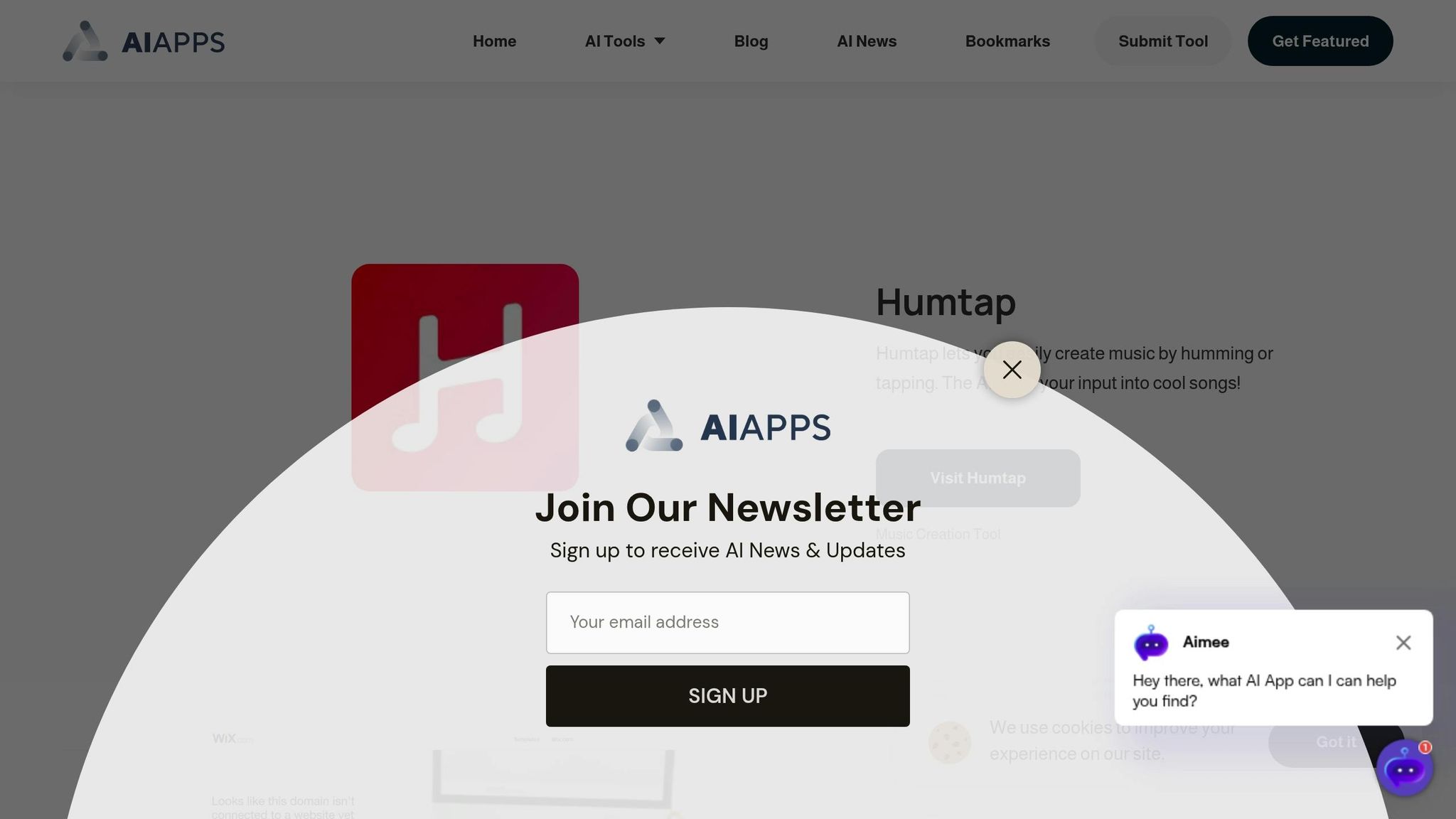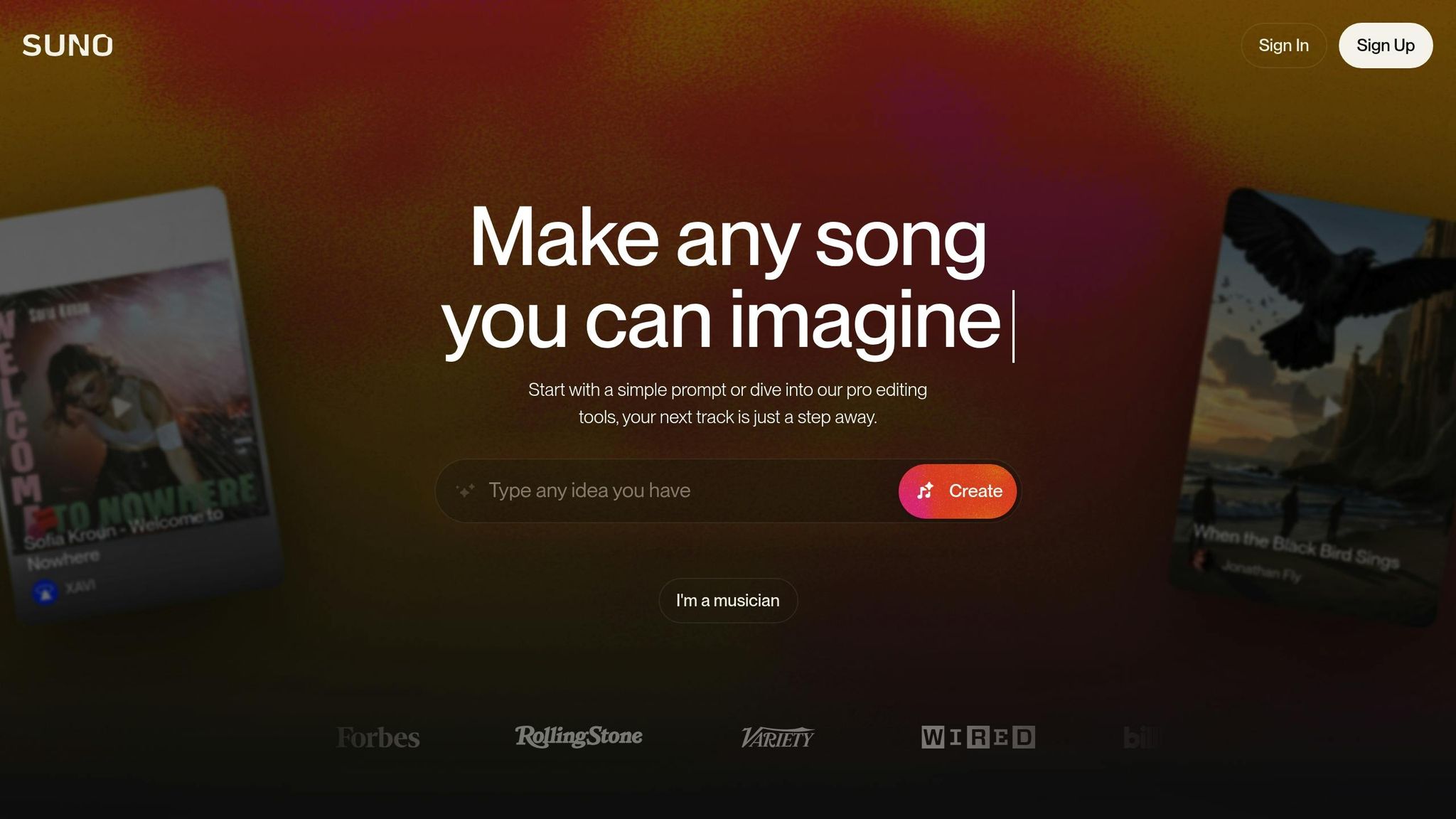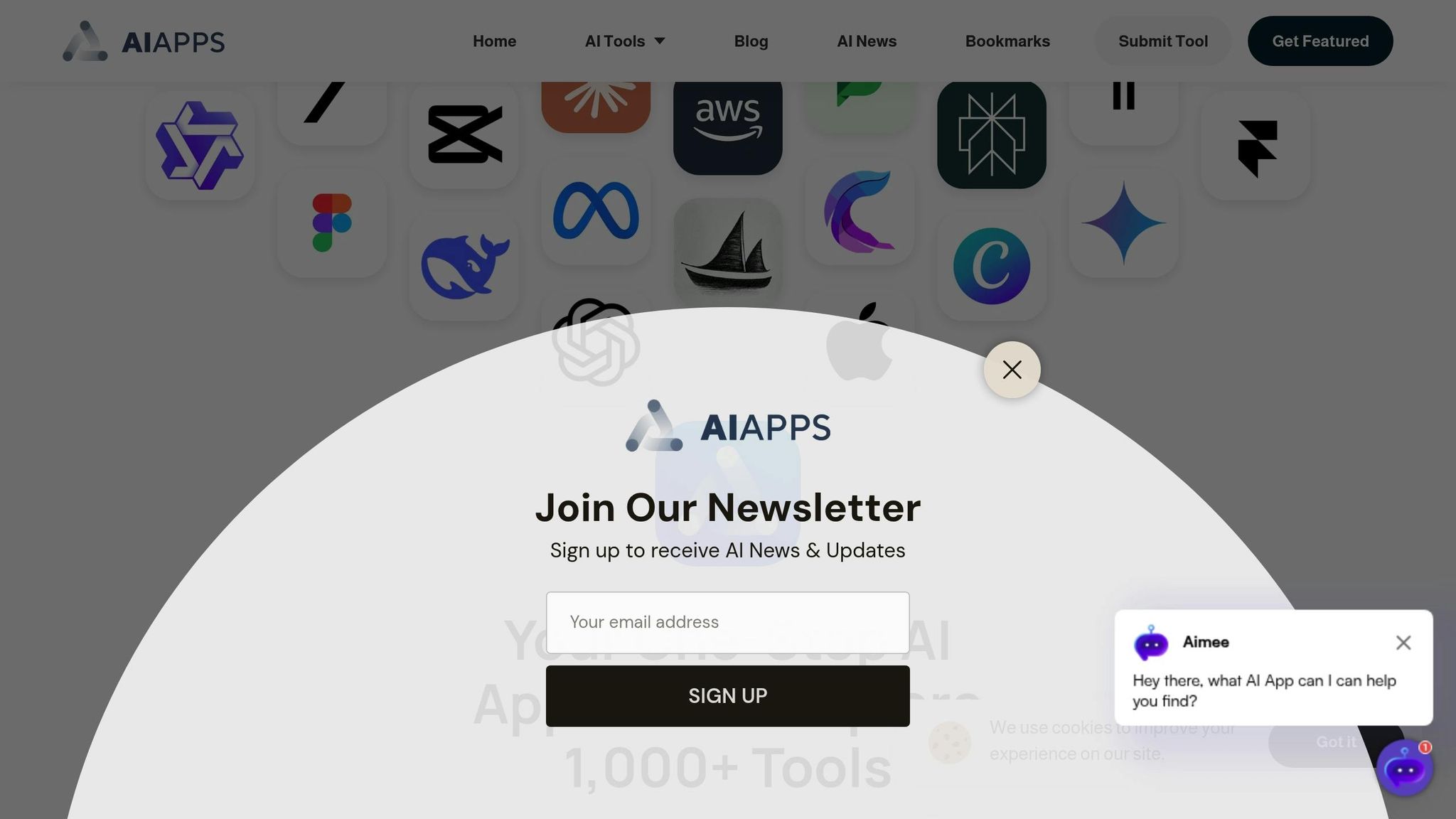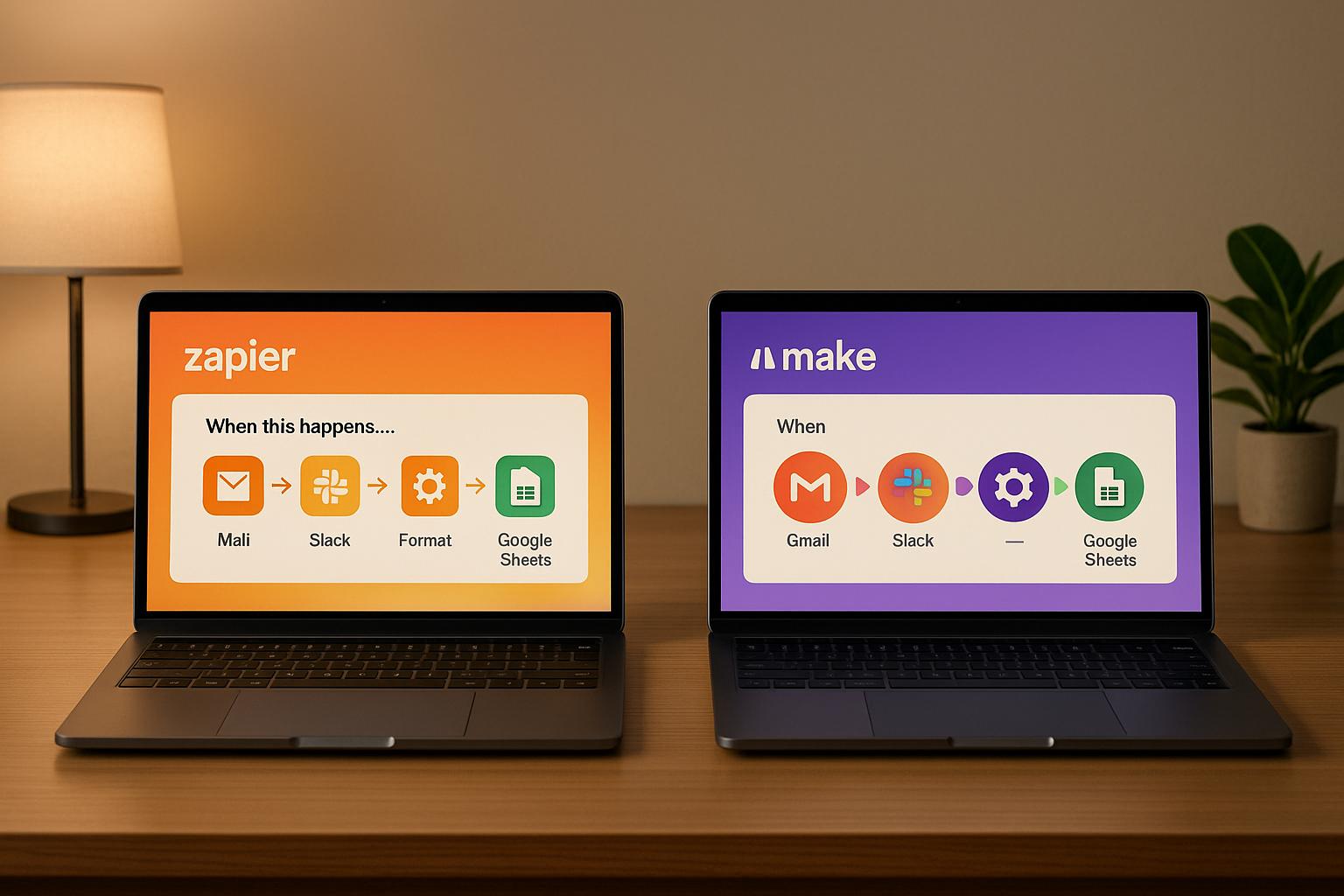Both Humtap and Suno AI are AI-powered tools that make music creation accessible for everyone, but they cater to different needs. Here’s a quick breakdown:
- Humtap: A mobile app where you use voice, gestures, or emojis to create short music clips. Ideal for quick, fun projects like TikTok or Instagram content. Offers a free version with in-app purchases.
- Suno AI: A browser-based platform that generates full songs, including vocals and lyrics, from text prompts. Perfect for professional or long-form projects like podcasts, marketing, or songwriting. Free plan includes 50 daily credits, with paid plans starting at $8/month for commercial use.
Quick Comparison
| Feature | Humtap | Suno AI |
|---|---|---|
| Input | Voice, gestures, emojis | Text prompts |
| Output | Short clips | Full-length tracks |
| Audio Quality | Lower | Professional-grade |
| Genres | Limited | Wide variety |
| Customization | Minimal | Advanced options |
| Pricing | Free (in-app purchases) | Free (50 credits), $8+/month |
| Best For | Social media content | Professional projects |
Choose Humtap if you want fast, easy music creation for social sharing. Choose Suno AI if you need polished, detailed songs for professional or commercial use.
2024's Best AI Music Composition Tools: Essential Software for Creators
Humtap Overview

Humtap is a mobile-focused app designed to help users turn their musical ideas into reality using just their voice and gestures. While it aims to make music production more accessible, users have pointed out several hurdles that can affect the experience.
Limitations of Humtap
Some common challenges reported by users include:
- A steep learning curve that might not suit beginners.
- Performance issues on devices that aren’t Mac-based.
- Dependence on a strong and stable internet connection.
- Inconsistent sound quality for instruments.
- System crashes when handling intensive tasks.
- Problems with exporting files seamlessly.
- Concerns about privacy, particularly regarding the handling of voice recordings and creative content.
Next, we’ll explore the standout features of Humtap and identify who can gain the most from its offerings.
Suno AI Overview

Suno AI takes text prompts and transforms them into fully-produced songs through its text-to-music generation technology. Unlike Humtap, which relies on gesture-based inputs, Suno AI uses written commands to create detailed compositions. This browser-based platform allows users to craft complete tracks with vocals and instruments, all from a simple text description.
Accessible on various devices, Suno AI lets users describe their desired music in plain English, and the AI handles everything - from creating melodies to synthesizing vocals. This makes it possible to produce polished songs without any prior experience in music production.
Key Features of Suno AI
Suno AI's text-to-music generation is its standout feature. Users can type prompts like "upbeat pop song", and within minutes, the platform delivers a fully-formed track. It supports multiple languages for both input and generated vocals, making it appealing to users across the globe.
The platform's vocal synthesis capabilities are particularly impressive. Users can specify details like gender, vocal style, and emotional tone, resulting in realistic and varied vocals. This eliminates the need for recording equipment or hiring vocalists, while still delivering professional-quality results.
Another highlight is its genre flexibility. Whether you’re looking for electronic dance music, classical pieces, folk tunes, or heavy metal, Suno AI can create tracks that align with genre-specific conventions. It adjusts instrumentation, rhythms, and production techniques to suit the requested style.
For those seeking more control, the platform offers customization options. Advanced users can define instruments, song structure, tempo, key signatures, and even lyrical themes. This balance of simplicity and precision makes it an attractive tool for both beginners and experienced creators.
Additionally, the batch generation feature allows users to create multiple versions of the same prompt. This provides a range of options to choose from, helping users refine their musical ideas more effectively. While these features are impressive, it’s equally important to consider the platform's challenges.
Limitations of Suno AI
Despite its strengths, Suno AI does come with some drawbacks. One of the main issues is limited fine-tuning. If users want to tweak specific elements like drum patterns or guitar riffs, they often need to regenerate the entire track, which can be time-consuming.
The quality of generated tracks can also vary. While some songs sound polished, others might suffer from awkward transitions, unnatural vocal phrasing, or poorly mixed instruments. The results largely depend on the complexity and clarity of the user’s prompt.
Another concern is copyright and licensing uncertainty. The legal framework for AI-generated music is still evolving, which can complicate commercial use of the tracks. This lack of clarity may limit how users can monetize or distribute their creations.
Processing times can be an issue during busy periods. When server demand is high, users may experience delays, with some tracks taking several minutes to generate. In extreme cases, server overload can interrupt the process altogether.
Finally, the platform's limited editing tools pose a challenge. Users cannot easily modify specific sections, extend songs, or add extra layers without starting from scratch. These limitations make it less suitable for those needing detailed post-production capabilities.
Who Should Use Suno AI?
Suno AI is perfect for content creators who need quick, royalty-free music. Its ability to generate diverse tracks in a short time makes it ideal for creators producing videos, podcasts, or other media regularly.
Songwriters and composers can use the platform as a tool for brainstorming and overcoming creative blocks. While it’s not a replacement for traditional production, it’s a great way to generate ideas and prototypes that can be refined later.
For marketing professionals and small businesses, Suno AI offers an affordable way to create custom jingles, promotional music, or branded audio content without hiring a composer or paying for expensive licensing.
Hobbyists and music enthusiasts will also find the platform appealing. It provides an easy and fun way to experiment with music creation, even for those without technical expertise or production knowledge.
Lastly, educators can use Suno AI to teach musical concepts, explore different genres, or give students hands-on experience with composition. It’s a practical tool for making lessons more interactive and engaging.
Feature Comparison
Take a closer look at how Humtap and Suno AI stack up in features tailored for music creators.
Comparison Table: Features
| Feature | Humtap | Suno AI |
|---|---|---|
| Input Methods | Voice, gestures, text, and emojis | Text prompts only |
| Output Quality | Lower audio quality | Professional-grade audio with cleaner sound |
| Genre Variety | Limited musical styles and genres | Broad support for contemporary music styles |
| Customization | Limited customization | Advanced controls over tempo, instruments, pitch, and structure |
| Song Length | Short clips tailored for social media | Full-length songs with vocals and lyrics |
| Lyric Generation | Not available | Built-in lyric creation |
| Social Sharing | Direct integration with social platforms | Public profiles with link sharing |
| Learning Curve | No prior music skills required | Simple, text-based interface |
| Integration | Focused on social media sharing | Minimal Digital Audio Workstation (DAW) support |
| API Support | Not specified | Limited or none |
| Pricing | Free with in-app purchases | Free plan (50 daily credits) plus tiered subscriptions ($8–$30/month) |
| Commercial Use | Varies by subscription | Allowed only with paid plans |
This table outlines the standout differences, helping you identify which platform aligns with your needs.
Which Tool Excels in Specific Areas?
When diving deeper into their strengths, it’s clear that Suno AI is the go-to for full-song production. Its ability to create complete tracks, combined with advanced customization options, makes it ideal for detailed and professional projects. You can fine-tune elements like tempo, instruments, and pitch, giving you more creative control.
On the other hand, Humtap thrives in a different space. Designed with a mobile-first approach, it’s perfect for quickly generating short, engaging music clips for social media platforms like TikTok or Instagram. Its interactive input methods - like using voice, gestures, and emojis - make the music creation process both intuitive and fun.
For audio quality, Suno AI takes the lead with its polished, professional-grade sound, making it better suited for high-quality productions. Meanwhile, Humtap’s output works well for casual, social media-focused content.
In terms of genre variety, Suno AI supports a broader range of contemporary music styles, while Humtap is more limited in this area. Pricing also reflects their target audiences: Humtap’s free model with optional in-app purchases appeals to casual users, while Suno AI’s tiered plans, which include a free option with daily credits, cater to professionals seeking commercial-use options.
sbb-itb-212c9ea
Ease of Use and Best Use Cases
Ease of Use: Humtap vs. Suno AI
Humtap stands out with its mobile-first, user-friendly design. The app lets you create music in a snap - just hum a tune, make a gesture, type some text, or pick emojis to set the mood. Forget about needing to understand music theory; this app makes the process feel effortless. Within seconds, you’ll have a shareable musical clip. Its interface feels more like a social media app than a traditional music tool, making it approachable for anyone familiar with smartphone apps.
On the other hand, Suno AI takes a text-based approach. You simply describe what you want in plain language - something like, "make an upbeat pop song about summer vacation with female vocals" - and the AI generates a full track. While this method requires more precise prompts compared to Humtap’s freeform style, it’s still easy for users who are comfortable with text-based commands.
However, Suno AI’s advanced customization features come with a steeper learning curve. While basic prompts are straightforward, diving into its more intricate options may require some musical knowledge. These differences in user experience make each tool better suited to specific needs.
Best Use Cases for Each Tool
The differences in their ease of use naturally lead to distinct strengths and ideal scenarios for each platform.
Humtap is perfect for situations where speed and social sharing matter most. Its quick clip creation is a dream for content creators on platforms like TikTok, Instagram Reels, or YouTube Shorts. Whether you’re adding background music to a vlog, creating sound effects for a comedy sketch, or responding to trending topics with a musical twist, Humtap delivers fast results.
It’s also great for casual music lovers who want to capture ideas on the fly. Imagine walking down the street when a melody pops into your head - Humtap lets you record and develop that idea instantly, without needing a piano or complicated software.
Suno AI, with its ability to generate complete, polished tracks, shines in more professional or long-form use cases. Independent musicians can use it to create demo tracks, explore new styles, or overcome creative blocks. The tool’s capacity to produce instrumentals, vocals, and lyrics makes it a valuable ally for songwriters looking to bring their ideas to life.
For podcasters and video creators, Suno AI’s ability to generate full-length tracks is a game-changer. Unlike Humtap’s shorter clips, Suno AI can produce 3-4 minute compositions, perfect for background music in podcast episodes or longer video content. Its professional-grade audio quality also makes it suitable for commercial projects, especially for users on paid plans.
Additionally, small businesses, educators, and indie game developers can benefit from Suno AI’s versatile outputs and licensing options. Whether it’s background music for marketing videos, educational materials, or game soundtracks, Suno AI’s genre variety and customization features make it easy to align with specific brand or project needs - something Humtap’s more limited styles can’t quite match.
Discover More AI Music Tools on AI Apps

After comparing Humtap and Suno AI, it’s clear they’re just the tip of the iceberg when it comes to AI-powered music tools. AI Apps is a platform offering access to over 1,000 AI-driven tools, including a rich variety of music creation applications designed for different creative needs and skill levels. Think of it as a direct gateway to the tools you’ve been searching for.
AI Apps acts as a central hub for exploring the world of AI music technology. You can filter tools based on features, pricing, compatibility, and more. Whether you’re interested in text-to-music generation, real-time collaboration, or even classical composition, the platform helps you pinpoint exactly what you need.
What sets AI Apps apart is its rigorous multi-step verification process for every tool listed. This ensures you won’t waste time with broken links, outdated projects, or unreliable applications. Each tool undergoes manual review, user feedback analysis, and periodic re-evaluation to maintain high standards. Beyond Humtap and Suno AI, the directory includes numerous other music creation tools tailored to a wide range of creative goals.
For users in the United States, AI Apps makes navigation even easier by displaying prices in U.S. dollars and dates in the MM/DD/YYYY format. It also highlights tools that offer API access, plugin compatibility, or export options that integrate seamlessly with popular American software and platforms.
One of the platform’s standout features is the inclusion of expert reviews, user ratings, and testimonials for each tool. Instead of relying solely on promotional descriptions, you get real insights from users about output quality, ease of use, and customer support. These reviews make it simpler to find tools that align with your needs.
The directory is updated regularly to include the latest advancements. Whether you’re a podcaster searching for custom theme music, a songwriter in need of lyric assistance, or a content creator looking for royalty-free background tracks, AI Apps has the tools to elevate your creative projects.
Conclusion
Deciding between Humtap and Suno AI depends largely on how you like to kick off your creative process. If you're someone who naturally hums tunes or enjoys crafting vocal beats, Humtap is your go-to. It’s designed for users who prefer to start with their own vocal or rhythmic input, letting the AI expand and enhance those ideas into complete compositions.
On the other hand, Suno AI is a fantastic choice for beginners. With its text-based interface, you don’t need any musical background or even the ability to hum a tune. Just describe your vision, and the AI does the heavy lifting. It's perfect for casual creators - think "shower singers" - or anyone with a musical idea but no technical know-how to bring it to life.
For seasoned musicians and content creators, Suno AI provides advanced customization tools and professional-grade controls, making it ideal for building tracks that can be refined and developed further. Meanwhile, Humtap appeals to those who want to stay more involved in the initial creative process, offering a hands-on approach to shaping their music from the ground up.
FAQs
What sets Humtap and Suno AI apart in how they create music?
Humtap is built for those who enjoy starting with their own musical ideas - whether it’s humming a melody or tapping out a rhythm. It takes these inputs and transforms them into fully produced songs, making it ideal for users who like to bring their personal touch to the creative process.
In contrast, Suno AI specializes in text-to-music generation. Instead of beginning with a tune or beat, users can craft songs by simply describing their vision through written prompts. This approach is perfect for anyone who prefers to express their ideas in words rather than sounds.
The main distinction between the two lies in how they work: Humtap shapes your musical input into songs, while Suno AI creates music directly from descriptive text.
How do the pricing options for Humtap and Suno AI differ, and which is better for your needs?
Suno AI provides a tiered subscription model that starts with a free plan offering 50 daily credits. For those needing more, the Pro plan begins at $8 per month, and the Premier plan, which includes advanced tools and features, is available for $24 per month. This setup caters to both casual users and professionals, offering flexibility based on individual needs.
In contrast, Humtap follows a usage-based pricing model, which might be a better fit for hobbyists or users with occasional music creation needs. While specific pricing details aren't as clear, it's generally seen as a budget-friendly option.
If you require regular access to advanced features, Suno AI might be the better option. However, if your music creation needs are infrequent and you're looking to save, Humtap could be a more suitable choice. Your decision should align with your budget and how often you plan to create music.
What challenges might users encounter when using Humtap or Suno AI for music creation?
When using Humtap or Suno AI, users might face a couple of hurdles. A frequent issue is sound quality - things like distortion or high-pitched tones can sometimes creep in, affecting the final track's smoothness. Another concern revolves around copyright. Questions about the originality and ownership of AI-generated music could potentially lead to legal headaches in some situations.
These tools bring a lot of potential to music creation, but keeping these technical and legal aspects in mind can help you navigate the process more effectively.



